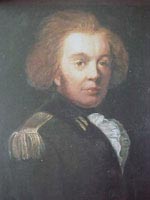

 | Lt.-Gov. Simcoe, c. 1795
Courtesy, Huron College
This portrait was presented to Reverend (later Bishop) Hellmuth when he visited two of the unmarried daughters of Col. Simcoe in the 1860s while collecting funds for the establishment of Huron College. It hangs in the College today. |
Simcoe selected the Forks of Thames as the capital of Upper Canada even before he left England and even before there was an Upper Canada. Early in 1791, he wrote to Sir Joseph Banks, President of the Royal Society: "I mean to establish a Capital in the very heart of the country, upon the River La Tranche (Thames) . . ."
 He made his first trip to the Forks in 1793 on his way back from a visit to Fort Detroit then still in British hands. He was guided by Mohawks from Thayendanegea's (Joseph Brant's) settlement on the Grand River. Accompanying him were several officers including Lt. Thomas Talbot, an officer of the 24th Regiment, then acting as his private secretary. He laid out a fairly detailed plan for the capitol probably as a result of this visit. The town was located on the south side of the Thames, as no treaty yet covered the lands on the north side. He made his first trip to the Forks in 1793 on his way back from a visit to Fort Detroit then still in British hands. He was guided by Mohawks from Thayendanegea's (Joseph Brant's) settlement on the Grand River. Accompanying him were several officers including Lt. Thomas Talbot, an officer of the 24th Regiment, then acting as his private secretary. He laid out a fairly detailed plan for the capitol probably as a result of this visit. The town was located on the south side of the Thames, as no treaty yet covered the lands on the north side.
 Relations with the Americans were tense during the 1790s and he wished to locate the capital far from any possible attack. In the end, he was ordered by the Governor-General at Quebec, Lord Dorchester, to establish the capital at York, now Toronto, which he did in late 1793. Relations with the Americans were tense during the 1790s and he wished to locate the capital far from any possible attack. In the end, he was ordered by the Governor-General at Quebec, Lord Dorchester, to establish the capital at York, now Toronto, which he did in late 1793.
|
 |
|